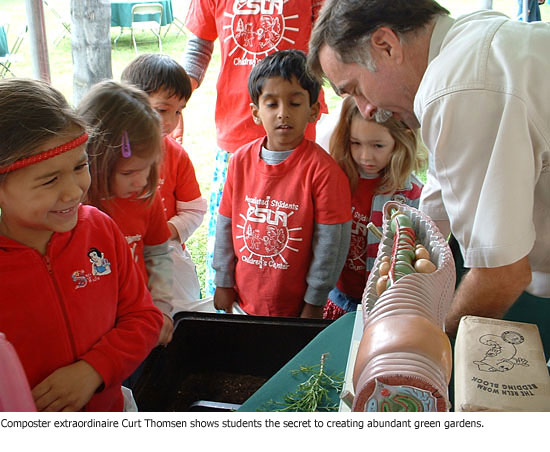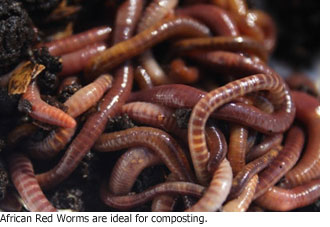Sowing the seeds of smart gardening
March 9, 2011
 For a dozen years, Curtis Thomsen has crisscrossed Los Angeles County, preaching the gospel of gardening.
For a dozen years, Curtis Thomsen has crisscrossed Los Angeles County, preaching the gospel of gardening.
Don’t throw away yard waste, he exhorts. Composting can reduce water consumption by up to 50% per household. And don’t forget the lowly earthworm.
“Worm tea is the strongest organic fertilizer there is,” he likes to say.
Thomsen, an environmental consultant and master gardener based in Cerritos, has conducted the Countywide Smart Gardening initiative for the Los Angeles County Department of Public Works since 1998. Launched 20 years ago as a way to reduce the amount of yard waste being sent to landfills, the program has grown to encompass not only green-waste recycling, but a range of assistance on the creation and maintenance of sustainable landscapes.
The county now operates nine demonstration and learning centers where visitors can learn—for free—about sustainable agriculture, native plants, water conservation and organic gardening. As a bonus, Thomsen’s weekend workshops offer subsidized compost and worm bins for $40 and $65, respectively—a healthy 60% discount.
Countywide Smart Gardening information stands have been installed in parks, schools, community gardens and nature centers. The program’s experts will make presentations at the L.A. County Fair in September and host a booth at the Natural History Museum next month as part of its “Sustainable Sundays” program on “edible landscapes.”
Public Works’ Smart Gardening Program Manager David Perez says the program has educated thousands of Southern Californians, who have been increasingly driven toward home gardening by concerns about the environment and sustainability.
“We do free workshops where the public can learn about composting, where they can see native plants and native gardens, where they can get a feel for the process,” says Perez. And one of the most popular features (besides the discounted composting apparatus) is Thomsen’s no-cost advice.
“I come from an agricultural background—we’ve done composting since I was about 5,” says Thomsen, who was born in San Gabriel and raised on farms in Oregon and Idaho. Thomsen earned bachelors degrees at Oregon State in business administration and statistics, with a special emphasis in agriculture.
 He returned to Southern California in the early 1990s to get his certifications in solid and hazardous waste management at UCLA, just as municipalities were working to comply with a then-new law requiring cities and counties to halve the waste they were sending to landfills. Thomsen and his brother, Keith, who holds a Ph.D. from UCLA in environmental science, began working with engineering consultants to help local governments set up composting facilities and recycling programs before the law’s 2000 deadline.
He returned to Southern California in the early 1990s to get his certifications in solid and hazardous waste management at UCLA, just as municipalities were working to comply with a then-new law requiring cities and counties to halve the waste they were sending to landfills. Thomsen and his brother, Keith, who holds a Ph.D. from UCLA in environmental science, began working with engineering consultants to help local governments set up composting facilities and recycling programs before the law’s 2000 deadline.
That expertise, he says, led to the creation of their own environmental consulting firm, BioContractors, Inc., through which Thomsen—with contract oversight from Public Works’ Perez—now runs Countywide Smart Gardening. Thomsen and his crew do 50 workshops a year at the learning centers, plus another 35 or so hosted offsite presentations that are co-sponsored by church groups, nonprofits and other municipalities. Spring is crunch time; between Earth Day observations and demand for spring planting information, his calendar is typically booked solid.
“Right now we’re at 31 events scheduled for April alone,” he says.
“The big push we like to do is vermi-composting because it has so much benefit to the environment,” Thomsen says. That’s composting with worms. Thomsen’s favorites are Eisenia fetida (also known as African Red Worms or Red Wigglers). Bred to thrive in the debris layer of jungle topsoil, they can process massive amounts of organic matter quickly, eating and excreting 80% to 100% of their body weight each day in food waste.
Besides aerating the soil, Thomsen says, they produce manure, or castings, that can be mixed with potting soil to create a high-nitrogen bioactive fertilizer. And, he says, the liquid from those castings—a substance called ‘worm tea’—can be diluted to create a systemic fertilizer, or used straight to kill gnats, aphids, white flies and most weeds.
Thomsen tells his audiences that even regular backyard composting can dramatically improve their garden yield—and make a crucial environmental difference. “The average person in L.A. County generates about a ton of garbage a year,” he says. “Forty percent of that is compostable.”
That’s 800 pounds of table scraps and grass clippings per year per person that could and should be fertilizing yards in L.A. County, “instead of going into a landfill.”
Is composting smelly? “No,” he says. “If you do it right, there should be no odor.”
Is it time-consuming? “No. About three minutes to put the bag of material in the bin and stir. You add water on a weekly basis.”
Does he compost at his house?
Here he laughs. Turns out Thomsen used to, but his current landlords, in Bellflower, are—for now—non-believers in his gospel.
“They won’t let me put in a composter, so I take all my stuff to the office. I have four worm bins there.”
Here is a video introduction to Backyard Composting, brought to you by L.A. County’s Countywide Smart Gardening program.

Posted 3/9/11












 405 bridge work causes a stink
405 bridge work causes a stink
